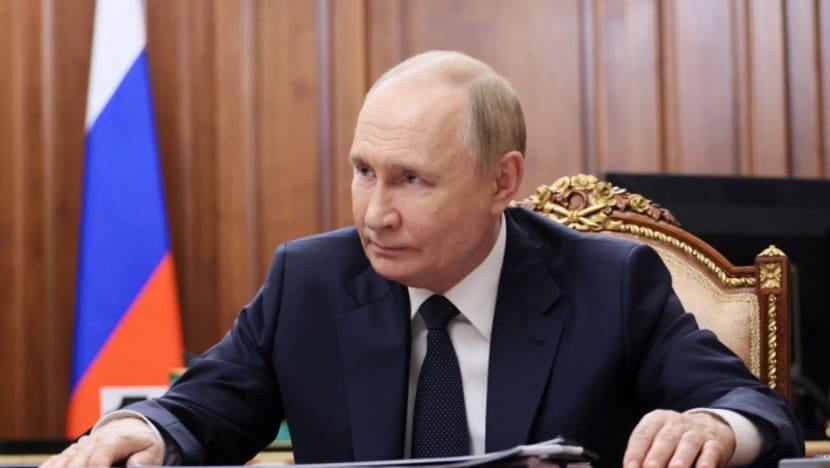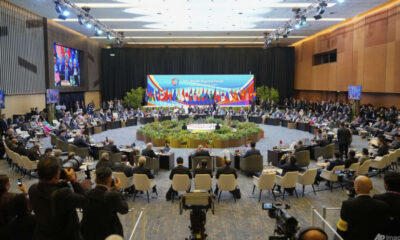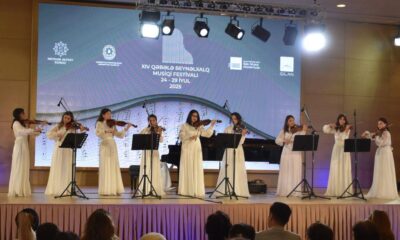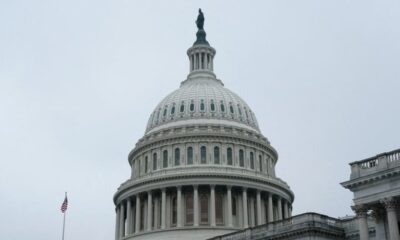Politics
Putin Demands Ukraine Withdraw from Donbas, Reject NATO Membership

Russian President Vladimir Putin has outlined significant demands for Ukraine during discussions with US President Donald Trump in Anchorage, Alaska, on August 16, 2024. According to three sources familiar with Kremlin discussions, Putin insists that Ukraine must cede the eastern Donbas region, abandon its aspirations to join NATO, maintain a stance of neutrality, and exclude Western troops from its territory.
In a closed three-hour meeting, their first in over four years, Putin and Trump reportedly scrutinized potential compromises regarding Ukraine. Following the meeting, Putin expressed hope that these discussions might pave the way for peace, though neither leader provided specific details on their negotiations.
Putin’s proposals represent a shift from earlier demands made in June 2024, where he insisted on Ukraine relinquishing control over the entirety of four provinces—Donetsk and Luhansk, along with Kherson and Zaporizhzhia. These terms were met with strong resistance from Kyiv, which viewed them as a form of surrender. The latest demands maintain the expectation that Ukraine withdraw from the parts of Donbas it still controls, while offering assurances to halt military advances in Zaporizhzhia and Kherson.
According to estimates from the United States and open-source data, Russia currently controls around 88 percent of the Donbas region and 73 percent of Zaporizhzhia and Kherson. The Kremlin is also open to returning small portions of the Kharkiv, Sumy, and Dnipropetrovsk regions of Ukraine under a potential agreement.
Putin continues to demand a legally binding commitment from NATO to refrain from further eastward expansion and seeks to limit the capabilities of the Ukrainian military while ensuring that no Western troops are deployed in Ukraine for peacekeeping purposes. Despite these negotiations, significant differences remain between the two sides, especially as Ukraine’s Foreign Ministry has yet to comment on the proposals.
President Volodymyr Zelenskyy has consistently rejected the notion of withdrawing from internationally recognized Ukrainian territories, viewing the industrial Donbas as a critical defensive line against Russian incursions. In a recent statement, he said, “If we’re talking about simply withdrawing from the east, we cannot do that. It is a matter of our country’s survival, involving the strongest defensive lines.”
Zelenskyy’s commitment to NATO membership remains a strategic goal enshrined in Ukraine’s constitution, with Kyiv viewing this alliance as its most robust security guarantee. He has asserted that the decision to join NATO is not one for Russia to dictate.
The White House and NATO have not yet responded to inquiries regarding the Russian proposals. Political analyst Samuel Charap, a chair in Russia and Eurasia Policy at the RAND Corporation, noted that requiring Ukraine to withdraw from the Donbas is politically and strategically untenable for Kyiv. He remarked, “Openness to ‘peace’ on terms categorically unacceptable to the other side could be more of a performance for Trump than a sign of a true willingness to compromise.”
Russian forces currently occupy approximately one-fifth of Ukraine, an area comparable in size to the American state of Ohio. Sources close to the Kremlin indicated that the recent summit might represent the best opportunity for peace since the conflict began, as it involved specific discussions regarding Russia’s terms and reflected Putin’s willingness to negotiate.
“Putin is ready for peace— for compromise. That is the message that was conveyed to Trump,” one source stated. The Kremlin sources acknowledged uncertainty regarding Ukraine’s readiness to relinquish control of the remaining parts of Donbas, suggesting that failure to do so would likely prolong the conflict. They also expressed ambivalence about whether the United States would recognize any Russian-held territories in Ukraine.
Putin’s economic considerations appear secondary but not insignificant, given the vulnerability of the Russian economy and the challenges associated with further military operations in Ukraine. Trump has emphasized his desire to end the “bloodbath” of the conflict and position himself as a “peacemaker president.” He mentioned plans to facilitate a meeting between Russian and Ukrainian leaders, potentially followed by a trilateral summit involving the US.
Russian Foreign Minister Sergei Lavrov stated that Putin is open to meeting Zelenskyy, but all issues must first be addressed, raising questions about Zelenskyy’s authority to finalize a peace agreement. Putin has previously expressed skepticism about Zelenskyy’s legitimacy, given the upcoming expiration of his term in May 2024 and the ongoing conflict preventing new elections. However, Kyiv maintains that Zelenskyy remains the legitimate president.
Leaders from Britain, France, and Germany have expressed skepticism regarding Putin’s genuine interest in ending the war. The path to a formal peace agreement remains intricate, with potential avenues including a three-way deal recognized by the United Nations Security Council or a revisit of the unsuccessful 2022 Istanbul agreements that discussed Ukraine’s neutrality in exchange for security guarantees from the five permanent members of the UN Security Council.
As discussions continue, one source summarized the situation succinctly: “There are two choices: war or peace, and if there is no peace, then there is more war.”
-

 Business5 months ago
Business5 months agoKenvue Dismisses CEO Thibaut Mongon as Strategic Review Advances
-

 Lifestyle4 months ago
Lifestyle4 months agoHumanism Camp Engages 250 Youths in Summer Fest 2025
-

 Sports4 months ago
Sports4 months agoDe Minaur Triumphs at Washington Open After Thrilling Comeback
-

 Sports5 months ago
Sports5 months agoTupou and Daugunu Join First Nations Squad for Lions Clash
-

 Top Stories5 months ago
Top Stories5 months agoColombian Senator Miguel Uribe Shows Signs of Recovery After Attack
-

 World5 months ago
World5 months agoASEAN Gears Up for Historic Joint Meeting of Foreign and Economic Ministers
-

 Health4 months ago
Health4 months agoNew Study Challenges Assumptions About Aging and Inflammation
-

 Business5 months ago
Business5 months agoOil Prices Surge Following New EU Sanctions on Russia
-

 Entertainment4 months ago
Entertainment4 months agoDetaşe-Sabah Violin Ensemble Captivates at Gabala Music Festival
-

 Entertainment4 months ago
Entertainment4 months agoBaku Metro Extends Hours for Justin Timberlake Concert
-

 Top Stories5 months ago
Top Stories5 months agoRethinking Singapore’s F&B Regulations Amid Business Closures
-

 Business5 months ago
Business5 months agoU.S. House Approves Stablecoin Bill, Sends to Trump for Signature









